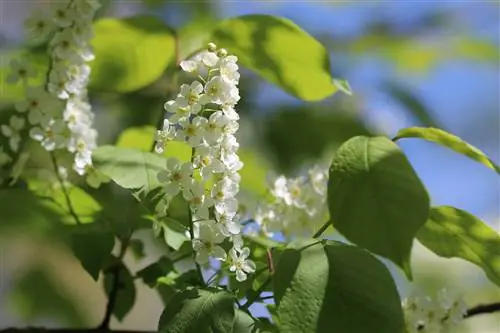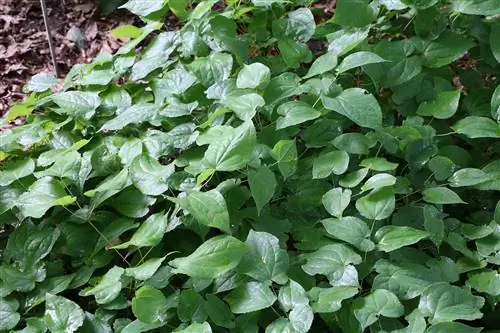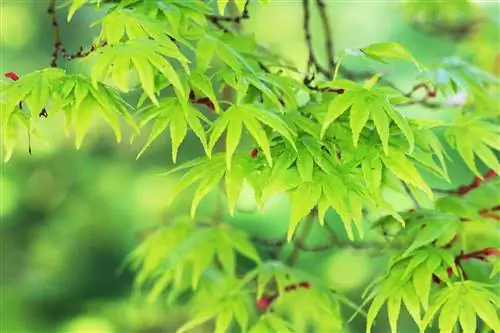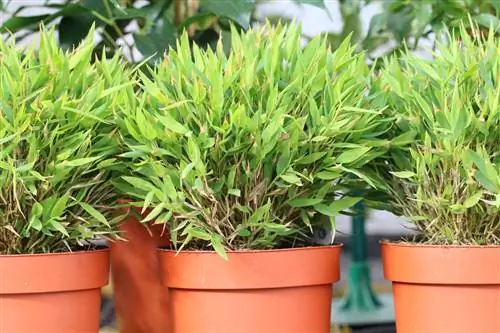- Author admin [email protected].
- Public 2023-12-17 03:39.
- Last modified 2025-01-24 12:45.
Plumbago originally comes from South Africa and reaches heights of up to four meters. In complete contrast to its rather dreary-sounding name, the plant is a striking ornamental shrub with overhanging or slightly climbing branches. All summer long in sunny locations, the leadwort never tires of presenting its sky blue or white, phlox-like flowers.
Profile
- Botanical name: Plumbago auriculata (Synonym: Plumbago caspensis)
- other names: plumbago, plumbago, cape plumbago
- Plant family: Plumbaginaceae (Plumbaginaceae)
- Growth habit: dense, upright growing shrub, slightly overhanging
- Growth height: 1.5 to 2 m
- Leaves: lanceolate with smooth edges
- Flowers: umbrella-like clusters with sky blue or white flowers
- Flowering period: May/June to September
- perennial
- not hardy
Usage
The Cape leadwort is unfortunately not hardy in our latitudes. For this reason, it is used almost exclusively as a container plant for balconies and terraces. The shrub grows vigorously and quickly, with branches spreading widely and beginning to climb. These properties create ideal conditions for a wide range of possible uses. The long, flexible shoots can be easily guided along a climbing frame or allowed to hang over a balcony railing. With a little patience, standard trunks can also be cultivated. Because of the enormous growth power, this requires a lot of work.
- perennial in pot culture with frost-free wintering
- annual culture in beds and borders
Location
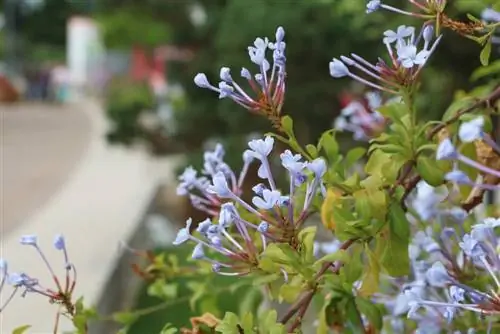
As its South African origin suggests, the leadwort wants to be as warm and sunny as possible. The shrub is therefore widespread as an ornamental plant in tropical and subtropical areas of the world. Because of its lack of frost hardiness, Plumbago auriculata is cultivated as a container plant in cooler areas. The general rule applies: the darker the location, the fewer flowers you can expect.
- Light requirements: full sun to light partial shade
- Root balls preferably in shade
- sheltered from the wind
- protected from rain (flowers rot when wet)
Substrate
The Plumbago has no special demands on the soil. It should be nutrient-rich, permeable and evenly moist. However, you should note that potted plants only have a limited amount of space available for their roots. When cultivating in planters, only use high-quality potted plant soil that can drain water well. At the same time, the substrate should be able to store moisture and nutrients well and remain permeable to air. You can also easily make a suitable substrate yourself from:
- Garden soil or potting soil
- Compost or humus (high proportion)
- coarse-grained components: lava granules, expanded clay or coarse sand
Planting partner
The lavish blue flowers of the Cape leadwort can be effectively combined with a pink bougainvilla or an oleander. The morning glory (Ipomoea purpurea) is one of the appropriate companion plants on trellises, providing a beautiful contrast. In balcony boxes, leadwort hangs beautifully between geraniums (pelargonium). And their simple light blue flowers also look good next to roses.
Plants
The planter for leadwort should be generous, because the shrub can only develop optimally with sufficient space for the roots. Large plant boxes and flower pots also have the advantage that a supportive trellis can be integrated. Pay attention to drainage holes in the soil, as waterlogging has a negative impact on the he alth of the plant. Underplanting provides shade in the root area and thus reduces the effort required for care.
- Material: plastic, clay or stone
- Cover drain holes with pottery shards
- Drainage layer: at least 5 cm of expanded clay or hydroponic granules
- Planting depth: as before
- Fill in soil and press lightly
- pour heavily
By the way:
Did you know that overheating in the root area of potted plants is less common in wooden or terracotta pots than in plastic containers?
Repotting
When a plant should be repotted depends on various factors. In general, younger leadworts have very strong root growth and therefore often require a larger pot than older, well-established shrubs. If the roots are already growing through the drainage hole, the plant should be repotted after overwintering. In most cases it is enough to pull the root ball out of the pot in spring and take a closer look. If there is already a dense, light network of roots on the outside and underside, it is time for a larger pot.
- Time: Spring
- after the end of the rest period (March to early May)
- young plants: annual
- older plants: every three years at the latest
- remove as much old substrate as possible
- possibly use a larger pot
- fill in fresh substrate and press firmly
Tip:
If a plant is over-fertilized or suffers from rotten roots due to waterlogging, it must be placed in new soil immediately. The season doesn't matter.
Pouring
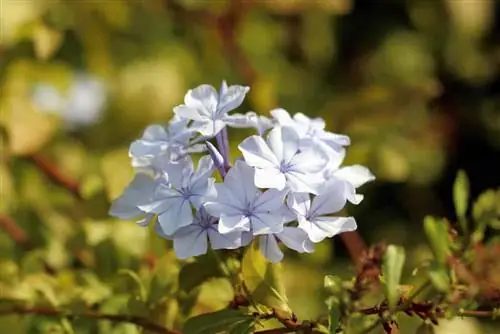
Almost all potted plants need a lot of water in summer. Cape leadwort is no exception. Preferably use rainwater or stale tap water for watering. The root ball should always be slightly moist, but never waterlogged. On hot days, we recommend watering early in the morning. Leave some water in the saucer to serve as a reserve throughout the day. If the leaves are already hanging limply at midday, do not wait until the evening before watering again. The plants need a particularly large amount of water under the following conditions:
- during the main growing season (May to September)
- in windy or full sun locations
- in high heat
- in a wooden or clay pot
- in relatively small planters
- for substrates with a high clay or sand content
In winter, the uniform soil moisture is maintained without producing waterlogging. As the leaf mass decreases, the water requirement naturally also decreases. Therefore, in a cool area, only water sips at a time.
Fertilize
No matter whether in the bed, in the bucket or in the planter: watering and fertilizing are part of the regular care of the ornamental shrub throughout the entire growing season. Between April and August, fertilize the plant weekly with a universal pot plant concentrate or liquid concentrate via the irrigation water. Alternatively, it is possible to use slow-release fertilizer. This needs to be refreshed in June. From mid-August onwards, stop fertilizing completely, as the soft plant tissue needs to woody slightly before overwintering.
Cutting
In order to keep its unbridled growth under control and to guarantee a permanent abundance of flowers, secateurs are the most important utensil when caring for the South African beauty. As tempting as it may be to simply leave the bush to its own devices, within just a few years it tends to become overgrown, out of shape and flowering very sparsely. Fortunately, a plumbago is very tolerant of pruning, so the growth can be easily kept under control. In addition, regular pruning is perfect to promote the formation of new flowers. Leadworms grow their flowers exclusively on annual wood. The more new shoots sprout, the more lush the blue flowers will be. Preferably cut in the following steps:
Autumn cut
- Time: before moving to winter quarters
- cut back faded shoots
- shorten by about half in total
Spring cut
- Time: February to March
- strong pruning down to 25 cm per shoot
- remove all dead or diseased shoots
- cut branches growing inwards
Care and maintenance cut
Shoots that are too long or sparse can be shortened at any time during the growing season. Also take this opportunity to check whether any branches are diseased or dead. Since the withered flowers do not fall off, you should also cut them out occasionally over the summer.
Tip:
In order to stimulate branching, it is a good idea to cut off the tips of the new shoots again after about a month.
Poisonous
The leadwort is considered slightly poisonous. The consumption of plant parts should therefore be avoided. However, little is known about the ingredients and mode of action of the toxic components. No he alth risks are to be expected in daily care.
Wintering
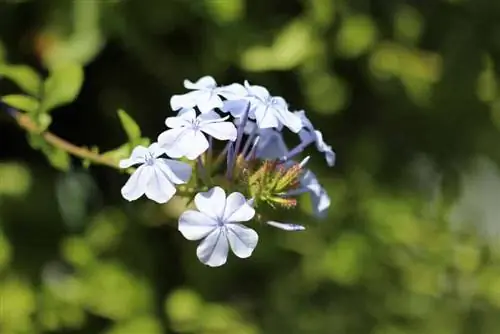
The otherwise robust potted plant is unfortunately not winter hardy, so it needs suitable quarters for the cold season. Although the heat-loving flowering shrub can tolerate a slight touch of frost, the plant usually cannot survive overwintering outdoors. In order not to take any risks, place the leadwort in a cool room before the first night frosts, at the latest when temperatures are below -5 degrees. Depending on the heat and light available, the plant sheds most of its leaves. Defoliated plants can also be kept dark, which makes overwintering and care much easier.
- hardy down to -5 degrees
- Staircase, basement, garage, cool winter garden
- Temperature: 5 to 10 degrees
- water only moderately
- Do not let the pot ball dry out completely
- check regularly for pest infestation
The new growth period for Cape leadwort begins in April. Place the plant a little warmer again and increase the amount of watering as new growth appears. If no more frosts are expected from mid-May, the plant can be returned outdoors.
Tip:
When putting them into winter quarters, the plants should not be too wet, otherwise there is a risk of rot.
Propagation
Plumbago can be propagated both from seeds and using cuttings. Propagation from cuttings promises greater success.
- Time: May to June
- Use half-ripe shoots (only slightly woody)
- Shoot tips without flowers
- Length: 15 cm
- tear off carefully
- remove lower leaves
- 2 to 4 top leaves preserved
- Substrate: loose, nutrient-poor soil (cactus soil, seed soil)
Put the shoot about five centimeters deep into the moistened substrate and press the soil lightly. To prevent excessive evaporation, put a plastic bag or a transparent plastic pot over it. In a bright location without direct sunlight, the cutting needs around four weeks to develop its first roots. Successful rooting can be recognized by the formation of new buds and leaves. Once the cutting has reached a height of 30 cm, the tip is cut off for better branching.
Diseases
Cape leadwort is considered to be less susceptible to disease. However, gray mold can occasionally occur. Gray mold occurs primarily on wet flowers and leaves in the warm season. You can avoid it by regularly removing dead parts of the plant and using a location protected from the rain.
Pests
Check the plant regularly for sucking insects such as aphids or spider mites, especially during overwintering. A mild infestation can be treated with home remedies. A mixture of water, alcohol and a few drops of dishwashing liquid, which you spray primarily on the undersides of the leaves, has proven to be effective. After two weeks, this procedure must be repeated again to kill the offspring of the pests.


